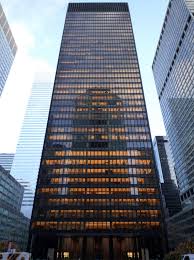Seagram Building
Contents |
[edit] Introduction
The Seagram Building is an iconic skyscraper located on Park Avenue in mid-town Manhattan, New York City. It was designed by architect Ludwig Mies van der Rohe in the International Style, which would influence the architectural style of New York’s skyscrapers for several decades.
Characterised by sleek glass and metal, rather than the ornamental heavy stone and brick facades of previous decades, the Seagram Building signalled a new era of functional skyscraper, adopting a minimalist, corporate aesthetic.
The building stands 157 m (515 ft) tall, with 38 storeys and was completed in 1958. It was originally designed as the headquarters for Joseph E. Seagram’s & Sons, and was Mies’ first tall office building project.
Today, it is owned by RFR Holdings and remains a prominent example of mid-century modernist architecture. However, it also has an Energy Star rating of 3 out of 100, the worst of any New York building.
[edit] Architectural design
[edit] Structure
One of the key traits of the International style was to articulate the structure of the building externally, rather than concealing it under applied ornamentation.
The Seagram Building was built using a combination of a steel moment frame and a steel and reinforced concrete core for lateral stiffness, one of the first buildings of its kind to do so. The structural engineering consultants, Severud Associates, claimed it was the first tall building to use high-strength bolted connections, and the first to combine a braced with a moment frame. In addition, it was one of the first buildings of its kind to use a vertical truss bracing system.
Mies had intended for the steel frame to be visible, however, this was prevented by the American building codes which required the covering of all structural steel with concrete or another fire-resistant material. To give the building the vertical articulation he wanted, Mies used non-structural bronze-toned I-beams instead, which run vertically (in the same way as mullions), surrounding the large glass windows, also helping to stiffen the skin for wind loading. This method of a larger non-structural edifice being supported by an interior reinforced concrete shell would go on to be widely adopted for other buildings.
[edit] Window blinds
A characteristic of the International style is the building’s uniform appearance. To avoid the undesirable, disordered irregularity of window blinds being drawn to different lengths, Mies specified blinds which were operationally limited to three positions – fully open, halfway open, or fully closed.
[edit] Interior
It was the use of expensive, high-spec materials and lavish decoration in the interiors which made the Seagram Building the world’s most expensive skyscraper at the time of its completion. The building used 1,500 tons of bronze, in addition to travertine and marble. This was intended to provide cohesion with the sleek, yet minimalist, external aesthetic.
[edit] Plaza
Another pioneering feature of the design was Mies’ decision to set the building back 100 ft from the edge of the street, creating an open plaza. This was part of his response to the dense environment of Manhattan, and was a rebuke to the conventional economics of skyscraper design and urban planning.
The plaza incorporates two large fountains and outdoor seating, encouraging the socialisation of the space, and providing a 'threshold' linking the city with the building.
Such plazas have now become something of an architectural cliché, but at the time it was celebrated as being innovative and unique.
[edit] Related articles on Designing Buildings Wiki
Featured articles and news
RTPI leader to become new CIOB Chief Executive Officer
Dr Victoria Hills MRTPI, FICE to take over after Caroline Gumble’s departure.
Social and affordable housing, a long term plan for delivery
The “Delivering a Decade of Renewal for Social and Affordable Housing” strategy sets out future path.
A change to adoptive architecture
Effects of global weather warming on architectural detailing, material choice and human interaction.
The proposed publicly owned and backed subsidiary of Homes England, to facilitate new homes.
How big is the problem and what can we do to mitigate the effects?
Overheating guidance and tools for building designers
A number of cool guides to help with the heat.
The UK's Modern Industrial Strategy: A 10 year plan
Previous consultation criticism, current key elements and general support with some persisting reservations.
Building Safety Regulator reforms
New roles, new staff and a new fast track service pave the way for a single construction regulator.
Architectural Technologist CPDs and Communications
CIAT CPD… and how you can do it!
Cooling centres and cool spaces
Managing extreme heat in cities by directing the public to places for heat stress relief and water sources.
Winter gardens: A brief history and warm variations
Extending the season with glass in different forms and terms.
Restoring Great Yarmouth's Winter Gardens
Transforming one of the least sustainable constructions imaginable.
Construction Skills Mission Board launch sector drive
Newly formed government and industry collaboration set strategy for recruiting an additional 100,000 construction workers a year.
New Architects Code comes into effect in September 2025
ARB Architects Code of Conduct and Practice available with ongoing consultation regarding guidance.
Welsh Skills Body (Medr) launches ambitious plan
The new skills body brings together funding and regulation of tertiary education and research for the devolved nation.
Paul Gandy FCIOB announced as next CIOB President
Former Tilbury Douglas CEO takes helm.
UK Infrastructure: A 10 Year Strategy. In brief with reactions
With the National Infrastructure and Service Transformation Authority (NISTA).























